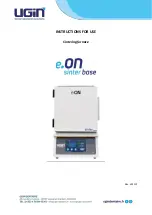
1083292-UIM-A-0114
Johnson Controls Unitary Products
33
An
unconfined space
is not less than 50 ft
3
(1.42 m
3
) per 1,000 BTU/
hr (0.2928 kW) input rating for all of the appliances installed in that
area.
Rooms communicating directly with the space containing the appli-
ances are considered part of the unconfined space, if doors are fur-
nished with openings or louvers.
A
confined space
is an area with less than 50 ft
3
(1.42 m
3
) per 1,000
BTU/hr (0.2928 kW) input rating for all of the appliances installed in that
area. The following must be considered to obtain proper air for combus-
tion and ventilation in confined spaces.
Dampers, Louvers and Grilles
The blocking effects of louvers, grilles and screens must be given con-
sideration in calculating free area. If the free area of a specific louver or
grille is not known, refer to Table 11 to estimate free area.
* Do not use less than 1/4” (6.4 mm) mesh.
+ Free area of louvers and grille varies widely; the installer should follow
louver or grille manufacturer’s instructions.
1.
The free area of a supply air opening shall be calculated by sub-
tracting the blockage area of all fixed louvers grilles or screens
from the gross area of the opening.
2.
Apertures in a fixed louver, a grille, or screen shall have no dimen-
sion smaller than 1/4” (6.4 mm).
3.
A manually operated damper or manually adjustable louvers are
not permitted for use.
4.
A automatically operated damper or automatically adjustable lou-
vers shall be interlocked so that the main burner cannot operate
unless either the damper or the louver is in the fully open position.
FIGURE 42:
Combustion Airflow Path Through The Furnace Casing
This type of installation requires that the supply air to the appli-
ance(s) be of a sufficient amount to support all of the appliance(s)
in the area. Operation of a mechanical exhaust, such as an exhaust
fan, kitchen ventilation system, clothes dryer or fireplace may cre-
ate conditions requiring special attention to avoid unsatisfactory
operation of gas appliances. A venting problem or a lack of supply
air will result in a hazardous condition, which can cause the appli-
ance to soot and generate dangerous levels of CARBON MONOX-
IDE, which can lead to serious injury, property damage and / or
death.
Table 11:
Estimated Free Area
Wood or Metal
Louvers or Grilles
Wood 20-25%*
Metal 60-70% *
1/4” (6.4 mm)
mesh or larger 100%
COMBUSTION AIR
Vent pipe clamps
into outlet of
drain coupling
When a Category I furnace is removed or replaced, the original
venting system may no longer be correctly sized to properly vent
the attached appliances.
An improperly sized vent system can cause CARBON MONOXIDE
to spill into the living space causing personal injury, and or death.
Table 12:
Unconfined Space Minimum Area
BTUH Input Rating
Minimum Free Area
Required for Each Opening
60,000
60 in
2
(387 cm
2
)
80,000
80 in
2
(516 cm
2
)
100,000
100 in
2
(645 cm
2
)
120,000
120 in
2
(742 cm
2
)
Table 13:
Free Area
BTUH Input
Rating
Minimum Free Area Required for Each Opening
Horizontal Duct
(2,000 BTUH)
Vertical Duct or
Opening to Outside
(4,000 BTUH)
Round Duct
(4,000 BTUH)
60,000
30 in
2
(193 cm
2
)
15 in
2
(97 cm
2
)
5” (13 cm)
80,000
40 in
2
(258 cm
2
)
20 in
2
(129 cm
2
)
5” (13 cm)
100,000
50 in
2
(322 cm
2
)
25 in
2
(161 cm
2
)
6” (15 cm)
120,000
60 in
2
(387 cm
2
)
30 in
2
(193 cm
2
)
7” (18 cm)
EXAMPLE: Determining Free Area.
Appliance
1 Appliance
2 Total Input
100,000
+ 30,000 = (130,000
4,000) = 32.5 Sq. In. Vertical
Appliance
1 Appliance
2 Total Input
100,000
+ 30,000 = (130,000
2,000) = 65 Sq. In. Horizontal
FIGURE 43:
Ambient Combustion Air
Gable
Vent
Gas
Vent
Soffit
Vent
Ventilated
Attic
Top Above
Insulation
Optional
Inlet (a)
Outlet
Air (a)
Ventilated
Crawl Space
Gas
Water
Heater
Furnace
Soffit
Vent
Gas
Water
Heater
Inlet
Air (a)
Inlet
Air (b)
Furnace
Gas
Vent
Outlet
Air (a)
Outlet
Air (b)
Inlet
Air (a)
Inlet
Air (b)
Gas
Water
Heater
Furnace
Ventilated
Attic
Top Above
Insulation
Gable
Vent
Gas
Vent














































